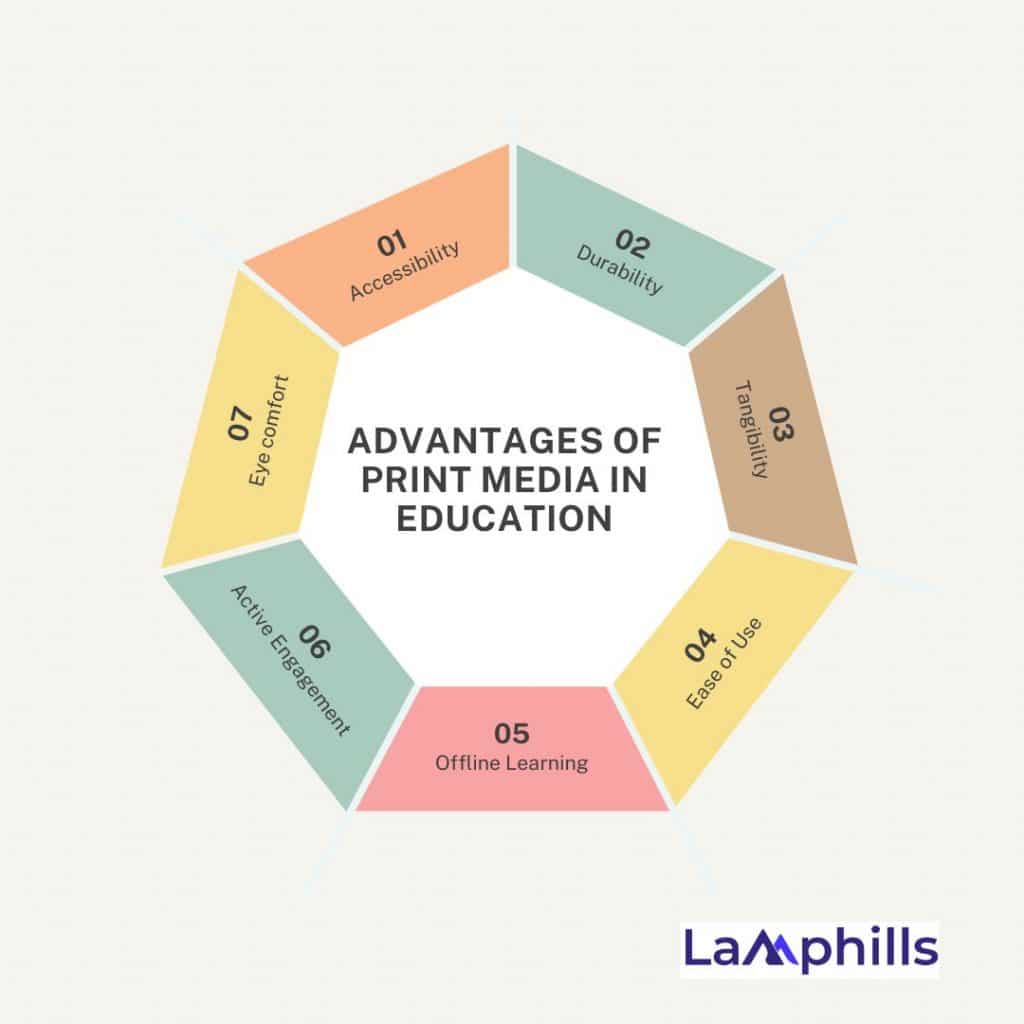With the current advancement in technology, our daily lives are increasingly dominated by screens and pixels, and it’s easy to overlook the essence of having tangible sources of information, especially in education. Print media plays an important role in shaping learning experiences and promoting academic success from textbooks and workbooks to posters and flashcards. In this article, we’ll explore the significance and role of print media in education, its advantages, and challenges, and how it continues to support learning outcomes in both traditional and digital classrooms.
Key Points
- Print media is a form of publishing that uses paper as its medium. It remains an integral part of modern education, notwithstanding the emergence of digital learning resources.
- Examples of print media used in education include textbooks, workbooks and practice sheets,
- Among the various advantages of print media in education are its ease of use, accessibility, tangibility, durability, offline learning, active engagement, etc.
What Is Print Media?
Print media is a form of publishing that uses paper as its medium. Examples include magazines, newspapers, flyers, and books. Print media has been in existence since the 15th century, with the emergence of the printing press, and it remains an important part of marketing to this day.
In the past few decades, print media has faced stiff competition from new media, such as the Internet and television. However, it still remains relevant in some contexts, especially in education.
History of Print Media
The origins of print media in education can be traced back to the invention of the printing press by Johannes Gutenberg in the 15th century. This groundbreaking innovation made books more accessible, leading to an educational revolution. Over the centuries, print media evolved from manuscripts to printed textbooks, becoming the backbone of educational systems worldwide. I recall my grandmother’s stories about using meticulously handwritten notes and scarce textbooks during her schooling. Today, while we have a good number of digital resources, learning from printed materials remains relevant and impactful.
Print Media in Modern Education
Print media remains an integral part of modern education, notwithstanding the emergence of digital learning resources. Textbooks, worksheets, and printed materials are staples in classrooms worldwide, providing students with tangible resources to support their learning journey.
Types of Print Media in Education
#1. Textbooks

Textbooks still form an important basis of structured learning. They offer a comprehensive and organized presentation of subjects, making it easier for students to follow and understand the curriculum. I still have fond memories of my high school textbooks, filled with highlighted sections and margin notes.
#2. Workbooks and Practice Sheets

Workbooks and practice sheets provide hands-on learning opportunities. They allow students to apply what they’ve learned, reinforcing concepts through repetition and practice. As a tutor, I’ve found that students really benefit from the immediate feedback and practice that workbooks offer.
#3. Academic Journals and Magazines

In higher education, academic journals and magazines are invaluable. They keep educators and students updated on the latest research and developments in their fields. During my university years, spending hours in the library poring over academic journals was a routine part of my studies. These resources helped me stay updated on new theories and practices, significantly enhancing my learning experience.
#4. Posters and Infographics
Visual aids like posters and infographics are powerful tools for enhancing understanding and retention. They simplify complex information, making it more accessible and engaging.
Advantages of Print Media in Education

Print media offers several advantages that contribute to its enduring relevance in educational settings:
#1. Accessibility
Print media helps to bridge the digital gap since not all students have reliable internet access or digital devices at home. Print materials ensure that every student, regardless of their socioeconomic status, has access to quality educational resources. In my experience working in diverse educational settings, I’ve seen how print media can level the playing field, providing all students with the opportunity to learn and succeed. In other words, print media is a leveller.
#2. Tangibility
One of the primary benefits of print media is its tangibility. There’s something inherently valuable about holding a book, underlining key points, and flipping back to previous pages. Studies have shown that students retain information better when they read from print rather than screens. I can readily agree that students are more engaged and focused during reading sessions with physical books compared to digital devices.
#3. Durability
Unlike digital devices, printed materials are durable and resistant to damage, making them ideal for repeated use in classroom environments.
#4. Ease of Use
Printed textbooks and workbooks are user-friendly and require no special training or technical skills to navigate, making them accessible to learners of all abilities. In fact, there’s something especially captivating about holding a physical book that you can’t get with digital media. You can flip through pages, write notes in margins, highlight important passages, and engage with the material.
#5. Offline Learning
Print media encourages offline learning, allowing students to engage with educational content anytime, anywhere, without needing an internet connection.
#6. Active Engagement
You’re less likely to get distracted when engaging with hard-copy material compared to reading online. Engaging with hard copy materials helps you to stay focused and improves productivity.
#7. Eye comfort
Staring at screens may cause digital eye strain and fatigue, whereas printed text is easier on your eyes and ensures longer comfort when studying.
My favourite part of school was actually going to the library to explore books on different topics and genres. Flipping through pages and stopping occasionally to take notes and ruminate on what I had read was more adventurous for me than just looking through a screen.
The Role Of Print Media in Promoting Literacy and Reading
Beyond textbooks and instructional materials, print media plays a vital role in promoting literacy and fostering a love for reading among students. Print-rich environments, such as classroom libraries and reading corners, provide opportunities for students to explore a variety of texts and develop essential literacy skills.
Promoting Literacy Through Print Media

#1. Diverse Reading Materials
Print media offers a diverse range of reading materials, including storybooks, newspapers, magazines, and graphic novels, each catering to students’ varying interests and reading levels.
#2. Independent Reading
Classroom libraries filled with print materials encourage independent reading habits, allowing students to choose books based on their preferences and explore topics of personal interest.
#3. Language Development
What better way to improve your language or learn a new one than print media? Print-rich environments support language development by exposing students to rich vocabulary, sentence structures, and literary devices found in written texts.
#4. Cultivating Imagination
Print media sparks imagination and creativity, transporting readers to new worlds and fostering a lifelong passion for storytelling and literature.
Supporting Learning Outcomes
Print media supports a wide range of learning outcomes and educational objectives, from building foundational skills to fostering critical thinking and problem-solving abilities. Whether used as a primary instructional tool or supplementary resource, print materials play a crucial role in enhancing learning experiences and academic achievement.
Key Learning Outcomes Supported by Print Media
#1. Comprehension
Printed texts allow students to practice reading comprehension skills, such as identifying main ideas, making inferences, and summarizing key points.
#2. Retention
Regular interaction with print materials enhances memory retention and recall, helping students retain and recall information more effectively than digital formats.
#3. Critical Thinking
Analyzing printed texts encourages critical thinking skills, such as evaluating arguments, identifying bias, and synthesizing information from multiple sources.
#4. Problem-Solving
Printed worksheets and activities offer hands-on opportunities for students to practice problem-solving skills, such as solving math problems, conducting experiments, and completing puzzles.
Adapting Print Media to Digital Trends
As technology keeps evolving, digital learning resources have become common in today’s classrooms. However, print media continues to adapt and evolve to complement these digital tools. By combining traditional print materials with innovative digital technologies, you can create a dynamic learning environment. Here are some best practices you can implement:
Strategies for Combining Print Media With Digital Resources
#1. Hybrid Learning Models
Adopting a hybrid learning approach that combines print and digital resources allows you to leverage the strengths of each medium while addressing the different needs of students.
For instance, textbooks can be supplemented with online quizzes and interactive modules. This hybrid approach combines the best of both worlds, enhancing student engagement and learning outcomes.
#2. QR Codes and AR in Print Media
Innovative technologies like QR codes and augmented reality (AR) can enhance print media, making it more interactive. By scanning a QR code in a textbook, students can access additional digital content, such as videos or interactive exercises. I’ve experimented with AR in my lessons, and it’s been fascinating to see how it brings static content to life, captivating students’ interest.
#3. Digital Collaboration Platforms
Online platforms and learning management systems (LMS) enable educators to distribute digital versions of print materials, facilitate collaboration among students, and provide instant feedback on assignments and assessments.
#4. Personalized Learning Paths
Adaptive learning software and personalized learning platforms leverage student data to tailor print and digital resources to individual learning needs, preferences, and proficiency levels.
Here’s a detailed checklist for your reference:
Challenges of Using Print Media In Education
While print media offers numerous benefits in educational settings, it also presents challenges that educators and institutions must navigate to maximize its effectiveness and relevance in today’s evolving world. From cost constraints to environmental concerns, addressing these challenges requires thoughtful planning and strategic implementation. Here are some challenges encountered with print media:
#1. Cost Constraints
The production and distribution of print materials can be costly, particularly for schools and institutions with limited budgets or funding constraints.
#2. Accessibility
Ensuring equitable access to print materials for all students, including those with disabilities or special learning needs, requires careful consideration of accessibility standards and accommodations.
#3. Environmental Impact
The environmental footprint of print media, including paper production, printing processes, and waste disposal, raises concerns about sustainability and environmental responsibility.
#4. Content Updates
Printed textbooks and materials may become outdated quickly, particularly in rapidly evolving fields such as science and technology, requiring frequent updates and revisions.
Despite the challenges posed by the digital age, print media continues to play a vital role in education, offering timeless benefits and opportunities for innovation. As technology continues to evolve, educators and institutions can leverage print media in creative ways to enhance learning experiences and promote student success.
Why Is It Called Print Media?
Print media is called “print media” because it involves the dissemination of information through printed materials such as newspapers, magazines, books, brochures, and flyers. The term highlights the physical production process where text and images are transferred onto paper or other tangible surfaces.
What Are The Four Print Media?
The four main types of print media are newspapers, magazines, brochures, and posters. Newspapers provide news and information on a daily or weekly basis. Magazines offer in-depth articles on specific topics or interests. Brochures are used for marketing and informational purposes. Posters are used for advertising and public information.
What Is Print Media In Library Science?
In library science, print media refers to physical materials such as books, newspapers, magazines, journals, and other printed publications. These resources are curated, catalogued, and made accessible to patrons for research, reference, and educational purposes within libraries.
What Was The First Print Media?
The first print media is widely recognized as the “Diamond Sutra,” a Buddhist text dated May 11, 868 AD. It was printed in China during the Tang Dynasty using woodblock printing. This ancient document marks a significant milestone in the history of printing and the dissemination of information.
What Are The Characteristics Of Print Media?
Print media is tangible, portable, and often more permanent than digital media. It includes newspapers, magazines, brochures, and books. Print media is characterized by its high-quality, detailed images and text, ability to reach local and niche audiences, and slower production cycle.
What Is The Difference Between Digital Media And Print Media?
Digital media involves content delivered through electronic devices, such as websites, social media, and e-books, offering interactive and multimedia capabilities. Print media includes physical formats like newspapers, magazines, and books, providing a tangible reading experience without digital interaction.
Who Founded Print Media?
Johannes Gutenberg is credited with inventing the first movable type printing press around 1440 in Mainz, Germany. His invention revolutionized the production of books and is considered the starting point of mass media and modern print media.
Conclusion
Print media remains an integral part of education, offering timeless benefits and opportunities for innovation in today’s digital age. From textbooks and workbooks to interactive posters and AR-enhanced materials, print media continues to shape learning experiences and support student success in both traditional and digital classrooms.
By embracing the unique strengths of print media and leveraging innovative technologies, you can create dynamic learning environments that inspire curiosity, promote literacy, and foster lifelong learning.
Related Articles
- BROADCAST MEDIA: Best Practices In 2024 (Updated!)
- EARNED MEDIA: Definition, Examples, and Best Practices
- Top Media Outlets in 2024: A Trustworthy Guide for Authoritative News Sources
- Media Coverage: Your Blueprint to Captivating Audiences and Making Headlines






